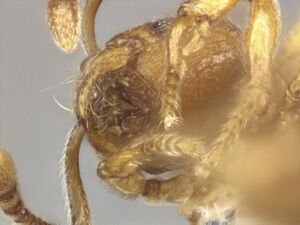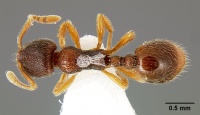Lordomyrma bhutanensis
| Lordomyrma bhutanensis | |
|---|---|

| |
| Scientific classification | |
| Kingdom: | Animalia |
| Phylum: | Arthropoda |
| Class: | Insecta |
| Order: | Hymenoptera |
| Family: | Formicidae |
| Subfamily: | Myrmicinae |
| Tribe: | Crematogastrini |
| Genus: | Lordomyrma |
| Species: | L. bhutanensis |
| Binomial name | |
| Lordomyrma bhutanensis (Baroni Urbani, 1977) | |
| Synonyms | |
| |
This species uses various habitats, such as semi-evergreen broadleaf forest, subalpine moist broadleaf forest, conifer-broadleaf mixed forest, alpine conifer forest and shrublands, often nesting in soil, decayed wood, leaf litter or under stone. Most individuals forage on the ground or in leaf litter and tend to be shy when disturbed (Liu, Xu & Hita Garcia, 2021).
Identification
Keys including this Species
Distribution
Lordomyrma bhutanensis is a common alpine species widely distributed in the Himalayas, Mt. Hengduanshan, and Mt. Qinling, basically occurring from Bhutan, east to Tibet, Yunnan, Sichuan and Shaanxi in China. The species has an altitudinal range of 1500 m to 3760 m. (Liu, Xu & Hita Garcia, 2021)
Latitudinal Distribution Pattern
Latitudinal Range: 33.65° to 33.65°.
| North Temperate |
North Subtropical |
Tropical | South Subtropical |
South Temperate |
- Source: AntMaps
Distribution based on Regional Taxon Lists
Oriental Region: Bhutan (type locality), Nepal.
Distribution based on AntMaps
Distribution based on AntWeb specimens
Check data from AntWeb
Countries Occupied
| Number of countries occupied by this species based on AntWiki Regional Taxon Lists. In general, fewer countries occupied indicates a narrower range, while more countries indicates a more widespread species. |

|
Estimated Abundance
| Relative abundance based on number of AntMaps records per species (this species within the purple bar). Fewer records (to the left) indicates a less abundant/encountered species while more records (to the right) indicates more abundant/encountered species. |

|
Biology
Castes
 
| |
| . | Owned by Museum of Comparative Zoology. |
Images from AntWeb

| |
| Specimen code casent0126076. . | |
Nomenclature
The following information is derived from Barry Bolton's Online Catalogue of the Ants of the World.
- bhutanensis. Stenamma bhutanense Baroni Urbani, 1977b: 420, figs. 2, 4 (w.) BHUTAN.
- Combination in Lordomyrma: Branstetter, 2009: 48.
- See also: DuBois, 1998b: 304.
- Senior synonym of sinensis: Liu, Xu & Hita Garcia, 2021: 9.
- sinensis. Stenamma sinensis Ma, Xu, Makio & DuBois, 2007: 372, figs. 1-4 (w.) CHINA.
- Combination in Lordomyrma: Branstetter, 2009: 49.
- Junior synonym of bhutanensis: Liu, Xu & Hita Garcia, 2021: 9.
Type Material
- Stenamma sinensis: Holotype, 2 workers, Mr. Qinling, Shaanxi, China, 33°39′0″N 107°48′0″E / 33.65°N 107.8°E, 7-18 September 2005/1-13 August 2006, Li-Bin Ma, Museum of Comparative Zoology.
- CHINA: Mr. Qinling, Shaanxi, 7-18 September 2005, 1-13 August 2006, Li-Bin Ma. The geographic coordinates of the type locality is about 107° 48’ E by 33° 39’ N, and the elevation of collections range from 1580m to 1641m. Holotype worker is deposited in Institute of Zoology, Shaanxi Normal University, Xi’an, China. 26 paratype workers are deposited as follows: Institute of Zoology, Shaanxi Normal University, Xi'an, China, 10 paratype workers, College of Biology Guangxi Normal University, Guilin, China, 10 paratype workers. Mark DuBois Personal Collection, 116 Burton St., Washington, IL 61571 U.S.A, four paratype workers. Museum of Comparative Zoology, two paratype workers. Holotype specimen bears a red, partly handwritten label: Lordomyrma sinensis Holotype. Paratype workers bear yellow, partly handwritten labels: Lordomyrma sinensis Paratype (Liu, Xu & Hita Garcia, 2021).
Taxonomic Notes
Liu, Xu & Hita Garcia (2021) could not find any significant phenotypical differences between L. bhutanensis and L. sinensis and therefore consider them to be synonyms.
Description
References
- Baroni Urbani, C. 1977b. Ergebnisse der Bhutan-Expedition 1972 des Naturhistorischen Museums in Basel. Hymenoptera: Fam. Formicidae Genus Stenamma, con una nuova specie del Kashmir. Entomol. Basil. 2: 415-422.
- Branstetter, M.G. 2009. The ant genus Stenamma Westwood redefined, with a description of a new genus Propodilobus. Zootaxa 2221: 41-57.
- Dendup, K.C., Dorji, C., Dhadwal, T., Bharti, H., Pfeiffer, M. 2021. A preliminary checklist of ants from Bhutan. Asian Myrmecology 14, e014005 (doi:10.20362/am.014005).
- Dhadwal, T., Bharti, H. 2023. Lordomyrma mewasinghi, a new species of the ant genus Lordomyrma (Hymenoptera: Formicidae) from India. Asian Myrmecology 16, e016001 (doi:10.20362/am.016001).
- DuBois, M. B. 1998a. A revision of the ant genus Stenamma in the Palaearctic and Oriental regions (Hymenoptera: Formicidae: Myrmicinae). Sociobiology 29: 193-403
- Eguchi, K., Bui, T.V. & Yamane, S. 2011. Generic synopsis of the Formicidae of Vietnam. Part 1 – Myrmicinae and Pseudomyrmecinae. Zootaxa 2878: 1-61.
- Liu, X., Xu. Z., Hita Garcia, F. 2021. Taxonomic review of the ant genus Lordomyrma Emery, 1897 (Hymenoptera, Formicidae) from China, with description of two new species and an identification key to the known species of the world. Asian Myrmecology 14: e014007 (doi:10.20362/am.014007).
- Ma, L.-B., Xu, S.-Q. & Makio, T., Dubois, M. 2007. A new species of the genus Stenamma from China. Sociobiology. 50:371-377.
- Subedi, I.P., Budha, P.B., Bharti, H., Alonso, L. 2020. An updated checklist of Nepalese ants (Hymenoptera, Formicidae). ZooKeys 1006, 99–136 (doi:10.3897/zookeys.1006.58808).
References based on Global Ant Biodiversity Informatics
- Branstetter M. G. 2009. The ant genus Stenamma Westwood (Hymenoptera: Formicidae) redefined, with a description of a new genus Propodilobus. Zootaxa 2221:41-57.
- DuBois, M. B.. "A revision of the ant genus Stenamma in the Palaeartic and Oriental regions." Sociobiology 32 (1998): 193-403.
- Guénard B., and R. R. Dunn. 2012. A checklist of the ants of China. Zootaxa 3558: 1-77.
- Liu X. 2012. Taxonomy, diversity and spatial distribution characters of the ant family Formicidae (Insecta: Hymenoptera) in southeastern Tibet. PhD Thesis 139 pages
- Liu X., Z. Xu, N. Yu, and C. Zhang. 2016. Distribution patterns of ant species ( Hymenoptera: Formicidae) in Galongla Mountains and Medog Valley of Southeastern Tibet. Scientia Silvae Sinicae 52(11): 88-95.
- Ma L.B.; S.Q. Xu, T. Makio, M. DuBois. 2007. A new species of the genus Stenamma (Hymenoptera: Formicidae) from China. Sociobiology 50: 371-377.
- Mo F., Z. Xu, Y. Song, C. Li, and Q. He. 2015. Ant communities in Yadong section of Mt. Himalaya. Journal of Nanjing Forestry University 39(3): 85-90.

